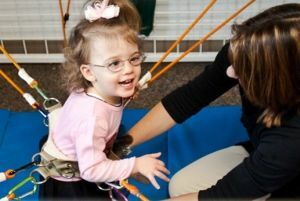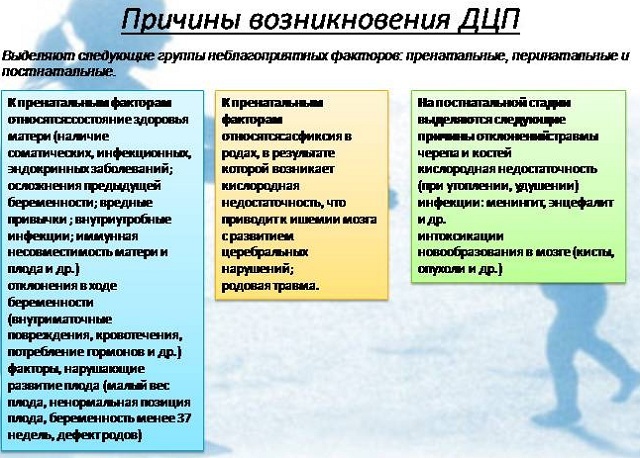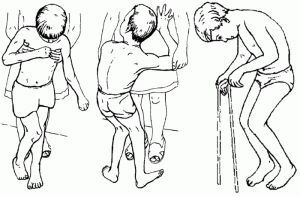 Cerebral Palsy( cerebral palsy) is a disease that causes disruptions in the functioning of the motor system, which arise as a result of damage to the brain areas or incomplete development.
Cerebral Palsy( cerebral palsy) is a disease that causes disruptions in the functioning of the motor system, which arise as a result of damage to the brain areas or incomplete development.
As early as 1860, Dr. William Little undertook to describe the disease, which was called Littlel's Disease. Even then it was revealed that the cause is oxygen starvation of the fetus at the time of delivery.
Later, in 1897, psychiatrist Sigmund Freud suggested that the source of the problem could be a developmental disorder in the child's brain in the womb. The idea of Freud was not supported.
And only in 1980 it was found that only in 10% of cases of cerebral palsy occurs during birth injuries. Since that time, experts have paid more attention to the causes of brain damage and, as a result, the emergence of infantile cerebral palsy.
Provoking intrauterine factors
Currently there are more than 400 causes of cerebral palsy. The causes of the disease are correlated with the period of gestation, delivery and in the first four weeks after( in some cases, the period of possibility of manifestation of the disease is extended to the age of three years of the child).
It is very important how the course of pregnancy passes. According to the research, it is during intrauterine development that in most cases violations of the fetal brain activity are observed.

Key causes that can cause dysfunction in the functioning of the developing child's brain, and the emergence of cerebral palsy during pregnancy:
- Preterm infants .A special group of risk includes babies who were born before the term. Statistics indicate that among them,
 40-50% suffer in the subsequent cerebral palsy. This is because the premature baby has still weakly developed organs, so the probability of hypoxia increases.
40-50% suffer in the subsequent cerebral palsy. This is because the premature baby has still weakly developed organs, so the probability of hypoxia increases. - Various diseases of the mother , which include rubella, heart disease, hypertension, obesity, anemia, diabetes, and trauma. According to medical observations, about 40% of children who have infantile cerebral palsy are born from mothers with acute and chronic diseases.
- plays an important role in the infectious processes of , which can occur in the body of a woman in a latent form. As a result, the child's body receives toxic poisoning, which affects the baby's brain. Particularly dangerous are diseases with viral infections( rubella, chickenpox, toxoplasmosis, herpes).According to the research, 22% of children with cerebral palsy had antibodies of various viruses in their bodies. The taking of medications has in some cases no less harm than the disease itself.
- Disturbance of pregnancy .Each woman individually carries the bearing of the fetus. Various factors contribute to this: physical and emotional health, compatibility of the mother with the fetus, and at the same time the risk of abortion, the presence or absence of toxicosis, etc. All these features can easily provoke a threat to the normal development of the fetus. If the mother has signs of toxicosis, impaired blood circulation in the placenta and in addition to the presence of infections, there is an oxygen starvation of the baby's brain. As a result of hypoxia, the reflexes of the child's body, the ability to maintain the balance of the body, often suffer in the future. The consequence of this is incorrect muscle work and problems with normal motor activity.
- Lifestyle mother .If a woman undergoes constant stress during pregnancy, has psychological problems
 , and even more abusers alcohol or tranquilizers, this is sufficient reason for the risk of developing a child's cerebral palsy.
, and even more abusers alcohol or tranquilizers, this is sufficient reason for the risk of developing a child's cerebral palsy. - Hemolytic disease in the newborn .Characterized by toxic poisoning of the child's brain as a result of incompatibility of blood of the mother and child or hepatic insufficiency of the baby.
- Complicated genera .Not only premature births can pose a threat to the health of the child, but also the occurrence of complications at the time of fetal release. Problems can be caused by the peculiarity of the female body: a very narrow pelvis, an irregular structure. The very process of the birth of a baby can be complicated by an incorrect position of the fetus, a time interval( labor is very long or, conversely, too fast).However, it is often believed that heavy births are already a consequence of the appearance of problems in the child during intrauterine development.
- Hereditary predisposition of .According to some experts, this cause is one of the leading causes of infantile cerebral palsy in newborns. The greater the degree of kinship, the higher the likelihood of developing similar disorders in the newborn.
Constraint factors
In the postpartum period, the risk of symptoms of cerebral palsy is reduced. But it also exists. If the fetus is born with a very low body weight, then this can be a danger to the health of the child - especially if the weight is up to 1 kg.
More at risk of diseases of twins, triplets. In situations where a child at an early age is injured in the brain, it is fraught with unpleasant consequences.

Scientific researches of
There are data according to which special importance in considering the risk of occurrence of infantile cerebral palsy should be given to the genetic issue.
 Norwegian doctors from pediatrics and neurology conducted a major study, which revealed a close relationship between the development of cerebral palsy and genetics.
Norwegian doctors from pediatrics and neurology conducted a major study, which revealed a close relationship between the development of cerebral palsy and genetics.
According to the observations of qualified specialists, if the parents already have a child suffering from this disease, the possibility of the appearance of another child in this family with cerebral palsy increases 9-fold.
To such conclusions, a research team led by Professor Peter Rosenbaum came as a result of studying data on more than two million Norwegian babies that were born between 1967 and 2002.3649 children were diagnosed with cerebral palsy.
Cases with twins were examined, situations were analyzed with relatives of the first, second and third degree of kinship. On the basis of these criteria, the incidence of cerebral palsy was revealed in babies belonging to different categories of kinship.
The following data were provided:
- if the twin is sick with cerebral palsy, the probability of the other twin's disease is increased by 15.6 times;
- if the brother or sister is sick, the risk of the appearance of another child suffering from infantile cerebral palsy increases 9-fold;if the half-uterine - 3 times.
- in the presence of cousins with a diagnosis of cerebral palsy, the threat of a baby having the same problem increases by a factor of 1.5.
- parents with this disease increase the likelihood of having a child with a similar diagnosis of 6.5 times.
It is necessary to know the causes and risk factors of infantile cerebral palsy, since its development can be prevented,  if it is premature to take care of the health of the mother and fetus.
if it is premature to take care of the health of the mother and fetus.
For this purpose it is necessary not only to visit a doctor on a regular basis, but also to observe a healthy lifestyle, avoid injuries, virus diseases, use of toxic substances, pre-treat and remember to consult for safety of medications.
Understanding the importance of precautions is the best prevention of infantile cerebral palsy.

